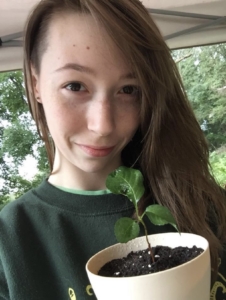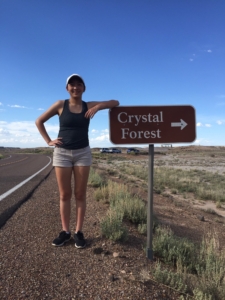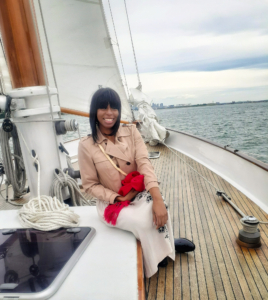Interns Making Moves That Start Movements
By Randy K. Rowel, C-StREAM Program Coordinator

The need for a robust, innovative, and diverse set of solutions on the restoration table is well-recognized by the partnership, and a diverse workforce to provide those solutions is critical to that end. Current data outlines the scope of the challenge: individuals from underserved and underrepresented populations have long comprised a disproportionately smaller percentage of degree recipients in the STEM fields, with underserved and underrepresented minority (URM) groups (African Americans, Hispanics, American Indians, Asian/Pacific Islanders, and Alaska Natives) collectively forming 28% of the U.S. population, but accounting for only 13% of the science and engineering workforce (NSB 2020). The disparity is similar or worse for the geoscience sub-sector, where the fraction of PhDs awarded to students who identified with the above minority populations averaged only 14% between 1976 and 2016, with no trend of change over time – the value was 15% in 2016 (Bernard and Cooperdock, 2018).
Clearly, this disparity is a major roadblock toward our member institutions’ long-stated desires of diversifying their faculty ranks, with hope that more diverse faculty might serve as role models and mentors who can help break the cycle of underserving certain segments of the population. Equally important, the government agencies and non-profit organizations within the Chesapeake Bay Program (CBP) partnership face similarly dramatic levels of under-representation, especially in leadership positions. A baseline (2016) survey conducted by the CBP’s Diversity Workgroup, established in 2014, revealed that only 13.7% of members and 9% of leadership in the CBP Partnership self-identified as people of color (CBP 2016), despite the population of people of color in the watershed being 35%.
How can we engage and broaden a leadership pipeline that attracts and retains a diverse community of both undergraduate mentees and mentors? This is a question that the Chesapeake Research Consortium (CRC) asked over four years ago, and those reflections gave rise to the Chesapeake Student Recruitment, Early Advisement, and Mentoring (C-StREAM) program. Its origin occurred under the leadership of Bill Ball, the CRC’s former Executive Director, with the support of US EPA, NOAA, and the CRC member institutions, and its goal is to develop and train a diverse population of future leaders in environmental research, restoration, and protection by engaging them over multiple years in mentored engaged scholarship experiences (summer internships and follow-up academic experiences).
The original program consisted of eight funded internship positions, with the CRC providing matching of students to internships and professional development support. The utilization of engaged scholarship experiences as a High Impact Practice (HIP) in preparing students for success is based on an influential book by George Kuh in 2008 titled “High-Impact Educational Practices: What They Are, Who Has Access to Them, and Why They Matter”. The book contained a powerful conclusion: high-impact practices have a pronounced effect on the experiences of underserved students, as evidenced by generally positive relationships between high-impact or engaged experiences and different measures of student learning and achievement, such as self-reported gains, grade point averages, and retention. But in several cases, these effects were more pronounced for students in identified groups: African American, Latino/a, and students with relatively low ACT scores.
Building off of that experience, with the support of our new National Science Foundation grant and the addition of our new C-StREAM Program Manager Randy Kenyatta Rowel, the program now seeks to include a wider range of students from other partner efforts into the program, increase the retention of students into sustained and individually tailored programs of engaged scholarship over multiple years, and to better mentor and inspire them in ways that will eventually allow them to take on positions of leadership in their discipline. Specifically, new innovations include the following:
- Employing a common language of leadership competencies that can be developed by the student through the program, so that multiple experiences can be woven together in a cohesive arc and tailored to the individual needs of the student;
- Building a strong sense of belonging by providing the Fellows with multiple and substantive opportunities to create community, enhance communication skills, and have shared professional development experiences;
- Creating a community of practice composed of professionally well-connected summer mentors who are are also also trained to be culturally aware, articulate in leadership competencies, and responsive to the student’s needs;
- Creating a new and highly regarded pipeline of environmental professionals by external facing outreach efforts such as news articles, stories, and symposiums where the expertise and talent of the students can be recognized.
As we engage our younger generations to become the next cohort to inherit the earth through practice and stewardship, we must be fully committed to take them to their next level in their life and career. In this edition of CRC Streamline, we invite you to glimpse into the future, into the direction of our program and the path it is taking and into the world of some of our young scholars as they make moves in shaping the future of our watershed.
Summer 2021 C-StREAM Interns
As evidence of our response of putting diversity into action, we highlight three C-StREAM scholars doing their part as change agents during the current renaissance of environmental leadership and sustainable development.
 Bailey Bosley is working with the EPA’s Chesapeake Bay Program Office’s Geographic Information Systems (GIS) Team this summer to explore a new approach of combining gaming engines and GIS. Her project, titled “Exploring the Use of Game Engines for GIS Data”, leverages a new GIS plug-in being developed by ESRI, ArcGIS Maps SDK for Unreal Engine, which enables a user to combine two powerful worlds: the 3D mapping available from GIS with the possibilities of creating immersive imagery and graphics that are present in gaming applications. Immersive experiences have been shown to greatly enhance the engagement and competencies of stakeholders in environmental decision-making, highlighting the potentially significant benefits of a method to create such experiences in an efficient, accessible, and cost-effective manner. She has been experimenting and exploring this new beta version while documenting its potential uses in the decision-making of the partnership; her specific tasks for this summer included:
Bailey Bosley is working with the EPA’s Chesapeake Bay Program Office’s Geographic Information Systems (GIS) Team this summer to explore a new approach of combining gaming engines and GIS. Her project, titled “Exploring the Use of Game Engines for GIS Data”, leverages a new GIS plug-in being developed by ESRI, ArcGIS Maps SDK for Unreal Engine, which enables a user to combine two powerful worlds: the 3D mapping available from GIS with the possibilities of creating immersive imagery and graphics that are present in gaming applications. Immersive experiences have been shown to greatly enhance the engagement and competencies of stakeholders in environmental decision-making, highlighting the potentially significant benefits of a method to create such experiences in an efficient, accessible, and cost-effective manner. She has been experimenting and exploring this new beta version while documenting its potential uses in the decision-making of the partnership; her specific tasks for this summer included:
- developing one or more gamification applications
- communicating place-based landscape change scenarios (e.g., sea level rise, flooding, population growth and development)
Bailey’s computer science expertise allows her to synergize the worlds of GIS and gaming to produce a unique visualization of environmental problems and disparities, leading to new approaches and solutions to complex challenges. The view of the world afforded by these technologies has heightened her awareness of the disparity gaps and how privilege plays a big part in shaping our worlds together or apart. She hopes that by organizing immersive and experiential ways to view the problems we face today, we can all experience the view that she has.
Bailey will continue her academic journey in the fall as an Environmental Science major on a Biology Track with a minor in GIS at Towson University. She has plans to continue her academic career, all the while refining the shape and content of that journey. That level of engagement in her educational journey is evidenced by her path to the C-StREAM program; she learned of it from one of the faculty in her department and she thought it would be a cool opportunity so she went for it! In her words, she is “still putting it all together”: her love for the environment and passion for science.
 Crystal Zhao is a young scholar who understands the need for the most diverse set of solutions to be brought to the table. Crystal is currently driving a movement to provide this wide and inclusive solution set by working within the Chesapeake Bay Program’s Diversity Workgroup under the mentorship of Tuana Phillips and Briana Yancy. Her project, “Community-Level Partnerships Within the Bay Program,” accelerates the accomplishment of the objectives in the Diversity Logic and Action Plan and Management Strategy by identifying underrepresented stakeholders that are not currently engaged with CBP’s restoration and conservation efforts, and developing and strengthening both new and existing partnerships in a substantive way.
Crystal Zhao is a young scholar who understands the need for the most diverse set of solutions to be brought to the table. Crystal is currently driving a movement to provide this wide and inclusive solution set by working within the Chesapeake Bay Program’s Diversity Workgroup under the mentorship of Tuana Phillips and Briana Yancy. Her project, “Community-Level Partnerships Within the Bay Program,” accelerates the accomplishment of the objectives in the Diversity Logic and Action Plan and Management Strategy by identifying underrepresented stakeholders that are not currently engaged with CBP’s restoration and conservation efforts, and developing and strengthening both new and existing partnerships in a substantive way.
In order to provide an engaging and informative example of diversity in action, Crystal developed a StoryMap highlighting the impact of community-level organizations and emphasizing the importance of cultivating meaningful, supportive, and mutually beneficial relationships between underrepresented stakeholders and the Bay Program. The Storymap seeks to illustrate the value of identifying the strengths within a community and using them as a framework of community liaisons, irrespective of technical or formal knowledge of environmental sciences and sustainability.
“As diversity, equity, inclusion, and justice (DEIJ) are integrated into restoration initiatives, the Chesapeake Bay Program must acknowledge the work that organizations and individual change-makers have been doing to effect positive change in their local communities and environments,” shared Crystal. She credits her increasing competency in navigating this diverse network to her mentors Tuana Phillips and Briana Yancy, who gave her the “trust and ability to openly and fearlessly talk about racism, inequalities, and not feel alone in the room.”
Crystal grew up exploring the waterways and creeks of Lake Erie, building her appreciation for the delicate balance of humans and the natural resources around them. She is engaged with numerous projects at the grassroots level in the Baltimore area, with programs such as Baltimore Compost Collective which has dealt with the big issue of incineration in the city. In the fall she will continue her studies, majoring in Environmental Science and Economics at Johns Hopkins University.
 Our third intern highlight goes to Dlynzee Damas. As a C-StREAM intern, Dlynzee is working with NOAA’s Chesapeake Bay Office to support the Chesapeake Bay Program’s Sustainable Fisheries Goal Implementation Team (GIT), a team composed of state fisheries managers from around the Bay and chaired by the director of the NOAA Chesapeake Bay Office. The Sustainable Fisheries GIT draws together a diverse group of managers and scientists to coordinate and facilitate improved management of blue crab and recovery of oysters, while promoting considerations of fish habitat and forage for key managed species like menhaden, striped bass and alosines.
Our third intern highlight goes to Dlynzee Damas. As a C-StREAM intern, Dlynzee is working with NOAA’s Chesapeake Bay Office to support the Chesapeake Bay Program’s Sustainable Fisheries Goal Implementation Team (GIT), a team composed of state fisheries managers from around the Bay and chaired by the director of the NOAA Chesapeake Bay Office. The Sustainable Fisheries GIT draws together a diverse group of managers and scientists to coordinate and facilitate improved management of blue crab and recovery of oysters, while promoting considerations of fish habitat and forage for key managed species like menhaden, striped bass and alosines.
Dlynzee’s project, titled “Chesapeake Bay CMECS Benthic Habitat: An Important Update”, utilizes the extensive digital representation of the distribution of seabed habitats throughout the Chesapeake Bay. The distribution maps are a critical tool in the coordination and facilitation of improved management of blue crab and recovery of oysters, while also promoting fish habitat and scrounge for key species like menhaden, striped bass and alosines. Newer survey data, with significantly better data quality, sourcing, and resolution, is replacing some of the old data, leading to information throughout the Bay that is no longer uniform. Dlynzee’s project consists of appropriately updating the existing substrate component database with these new data streams and creating new biotic and geoform component databases for the Chesapeake Bay using the Coastal Marine Ecological Classification Standard (CMECS). Her summer project has given her experience in:
- compiling data
- generating benthic terrain products
- interpreting data
- Identifying habitat segments and developing sampling plans for future field work
Dlynzee’s experience is the definitive definition of diversity in action; “this summer internship has given me a great opportunity to test what I have learned and the possibility to apply them in the real world.” She has not only gained work experiences in science communications this summer, but also has connected with motivated professionals and scientists who are making impacts on environmental and ecosystem conservation.
Dlynzee’s path to C-StREAM was also through the identification of the opportunity by a faculty member at her home institution, but her inspiration for this field of study originated long before and grew in her native Haiti. She is majoring in Environmental Science, with a concentration in Earth and Hydrologic Science at the University of Massachusetts Boston, while also minoring in Environmental Chemistry; she feels that her major allows her the freedom to explore the relationship between people and the environment. Her future plans are to eventually return to Haiti and create more opportunities to promote and preserve the natural environment and resources there.
CONCLUSION
Much more than being individual examples of diversity in action, these interns are creating movements by demonstrating the ability to apply their disciplinary expertise for global impact, in a socially-conscious and ethical way. Let’s make sure that we allow their ripples to expand ever further. Please join us at this week’s C-StREAM symposium to see just how many waves are in motion.
References
Bernard, R.E., Cooperdock, E.H.G., 2018. “No progress on diversity in 40 years. “ Nature Geosci 11, 292–295;. https://doi.org/10.1038/s41561-018-0116-6.
Chesapeake Bay Program 2016. Chesapeake Progress: Diversity. https://www.chesapeakeprogress.com/engaged-communities/diversity
National Science Board, 2020. https://ncses.nsf.gov/pubs/nsb20201/u-s-s-e-workforce
